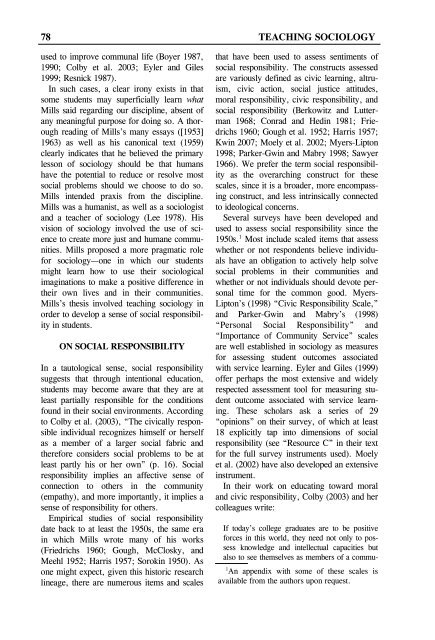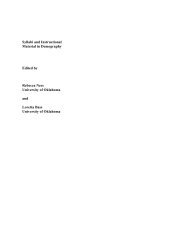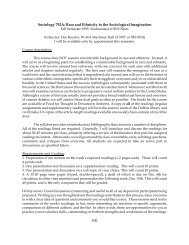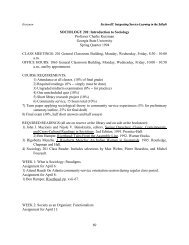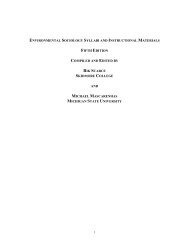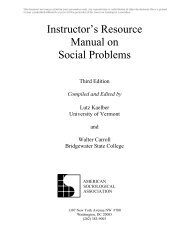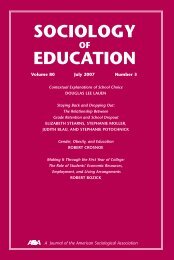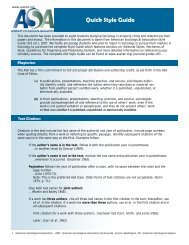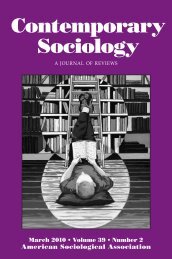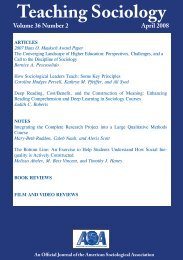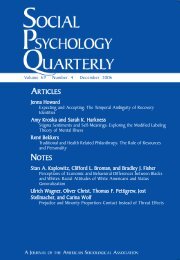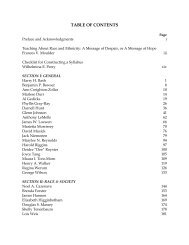Teaching Sociology - American Sociological Association
Teaching Sociology - American Sociological Association
Teaching Sociology - American Sociological Association
You also want an ePaper? Increase the reach of your titles
YUMPU automatically turns print PDFs into web optimized ePapers that Google loves.
78 TEACHING SOCIOLOGY<br />
used to improve communal life (Boyer 1987,<br />
1990; Colby et al. 2003; Eyler and Giles<br />
1999; Resnick 1987).<br />
In such cases, a clear irony exists in that<br />
some students may superficially learn what<br />
Mills said regarding our discipline, absent of<br />
any meaningful purpose for doing so. A thorough<br />
reading of Mills’s many essays ([1953]<br />
1963) as well as his canonical text (1959)<br />
clearly indicates that he believed the primary<br />
lesson of sociology should be that humans<br />
have the potential to reduce or resolve most<br />
social problems should we choose to do so.<br />
Mills intended praxis from the discipline.<br />
Mills was a humanist, as well as a sociologist<br />
and a teacher of sociology (Lee 1978). His<br />
vision of sociology involved the use of science<br />
to create more just and humane communities.<br />
Mills proposed a more pragmatic role<br />
for sociology—one in which our students<br />
might learn how to use their sociological<br />
imaginations to make a positive difference in<br />
their own lives and in their communities.<br />
Mills’s thesis involved teaching sociology in<br />
order to develop a sense of social responsibility<br />
in students.<br />
ON SOCIAL RESPONSIBILITY<br />
In a tautological sense, social responsibility<br />
suggests that through intentional education,<br />
students may become aware that they are at<br />
least partially responsible for the conditions<br />
found in their social environments. According<br />
to Colby et al. (2003), “The civically responsible<br />
individual recognizes himself or herself<br />
as a member of a larger social fabric and<br />
therefore considers social problems to be at<br />
least partly his or her own” (p. 16). Social<br />
responsibility implies an affective sense of<br />
connection to others in the community<br />
(empathy), and more importantly, it implies a<br />
sense of responsibility for others.<br />
Empirical studies of social responsibility<br />
date back to at least the 1950s, the same era<br />
in which Mills wrote many of his works<br />
(Friedrichs 1960; Gough, McClosky, and<br />
Meehl 1952; Harris 1957; Sorokin 1950). As<br />
one might expect, given this historic research<br />
lineage, there are numerous items and scales<br />
that have been used to assess sentiments of<br />
social responsibility. The constructs assessed<br />
are variously defined as civic learning, altruism,<br />
civic action, social justice attitudes,<br />
moral responsibility, civic responsibility, and<br />
social responsibility (Berkowitz and Lutterman<br />
1968; Conrad and Hedin 1981; Friedrichs<br />
1960; Gough et al. 1952; Harris 1957;<br />
Kwin 2007; Moely et al. 2002; Myers-Lipton<br />
1998; Parker-Gwin and Mabry 1998; Sawyer<br />
1966). We prefer the term social responsibility<br />
as the overarching construct for these<br />
scales, since it is a broader, more encompassing<br />
construct, and less intrinsically connected<br />
to ideological concerns.<br />
Several surveys have been developed and<br />
used to assess social responsibility since the<br />
1950s. 1 Most include scaled items that assess<br />
whether or not respondents believe individuals<br />
have an obligation to actively help solve<br />
social problems in their communities and<br />
whether or not individuals should devote personal<br />
time for the common good. Myers-<br />
Lipton’s (1998) “Civic Responsibility Scale,”<br />
and Parker-Gwin and Mabry’s (1998)<br />
“Personal Social Responsibility” and<br />
“Importance of Community Service” scales<br />
are well established in sociology as measures<br />
for assessing student outcomes associated<br />
with service learning. Eyler and Giles (1999)<br />
offer perhaps the most extensive and widely<br />
respected assessment tool for measuring student<br />
outcome associated with service learning.<br />
These scholars ask a series of 29<br />
“opinions” on their survey, of which at least<br />
18 explicitly tap into dimensions of social<br />
responsibility (see “Resource C” in their text<br />
for the full survey instruments used). Moely<br />
et al. (2002) have also developed an extensive<br />
instrument.<br />
In their work on educating toward moral<br />
and civic responsibility, Colby (2003) and her<br />
colleagues write:<br />
If today’s college graduates are to be positive<br />
forces in this world, they need not only to possess<br />
knowledge and intellectual capacities but<br />
also to see themselves as members of a commu-<br />
1 An appendix with some of these scales is<br />
available from the authors upon request.


